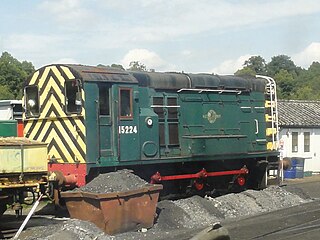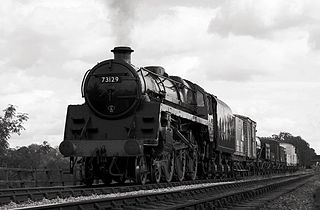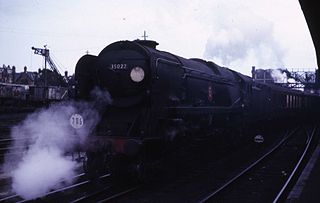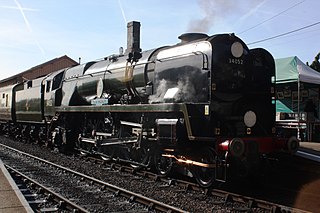
The British Rail Class 12 is a diesel locomotive built primarily for shunting duties around London.

The BR Standard Class 8 was a class of a single 4-6-2 Pacific steam locomotive designed by Robert Riddles for use by British Railways. Only the prototype was constructed, which was christened the name Duke of Gloucester. Constructed at Crewe Works in 1954, the Duke, as it is popularly known, was a replacement for the destroyed LMS Princess Royal Class locomotive number 46202 Princess Anne, which was involved in the Harrow and Wealdstone rail crash of 1952.

Woodham Brothers Ltd is a trading business, based mainly around activities and premises located within Barry Docks, in Barry, South Wales. It is noted globally for its 1960s activity as a scrapyard, where 297 withdrawn British Railways steam locomotives were sent, from which 213 were rescued for the developing railway preservation movement.

The British Railways Standard Class 5MT4-6-0 is one of the 12 BR standard classes of steam locomotive built by British Railways in the 1950s. It was essentially a development of the LMS Stanier Class 5 4-6-0. A total of 172 were built between 1951 and 1957.

No. 249 Squadron RAF was a Royal Air Force squadron, active in the sea-patrol, fighter and bomber roles during its existence. It was one of the top scoring fighter squadrons of the RAF in World War II.

The SR West Country and Battle of Britain classes, collectively known as Light Pacifics or informally as Spam Cans, or "flat tops", are air-smoothed 4-6-2 Pacific steam locomotives designed for the Southern Railway by its Chief Mechanical Engineer Oliver Bulleid. Incorporating a number of new developments in British steam locomotive technology, they were amongst the first British designs to use welding in the construction process, and to use steel fireboxes, which meant that components could be more easily constructed under wartime austerity and post-war economy.

4920 Dumbleton Hall is a GWR 4900 Class 4-6-0 steam locomotive, built by the Great Western Railway's Swindon Works in March 1929. Named after Dumbleton Hall, its first shed allocation was at Old Oak Common. In August 1950, the next shed allocation was Reading, and in March 1959 it was allocated to Newton Abbot. The locomotive's last shed allocation was Bristol Barrow Road. It was withdrawn from British Railways service in December 1965 and sold to Woodham Brothers scrapyard in Barry, Wales.

London, Midland and Scottish Railway (LMS) Jubilee Class No. 5699Galatea is a preserved British steam locomotive.

35027 Port Line was one of a batch of ten SR Merchant Navy class steam locomotives built by the Southern Region of British Railways between 1948 and 1949.

British Railways Standard Class 5 No. 73129 is a preserved British steam locomotive. It is the only surviving Standard Class 5 built by British Railways which was fitted with Caprotti valve gear.

SR Merchant Navy Class No. 35009 Shaw Savill is a 're-built' SR Merchant Navy class 'Pacific' (4-6-2) steam locomotive, named after the Shaw Savill Line, a British merchant shipping company. The locomotive was built at Eastleigh Works in June 1942 in its original air-smoothed form, and given the number 21C9. One of a batch of eight Merchant Navy class locomotives whose air-smoothed casing was made of asbestos board, 21C9 was from the start in wartime black livery. It was allocated to Salisbury shed.

35006 Peninsular & Oriental S. N. Co. is a Southern Railway rebuilt Merchant Navy Class 4-6-2 steam locomotive. It was built at Eastleigh locomotive works in December 1941 and given the Southern Railway number 21C6. Although the first two members of the Merchant Navy class had their air-smoothed casings made of sheet steel, 21C6 was one of eight in which the casing was made of asbestos board, with a visible horizontal fixing strip along the centre line.

British Railways Standard Class 5 No. 73096 is a preserved British steam locomotive, unnamed in service. It has spent most of its time in preservation in the care of the Watercress Line.
The Barry 10 was a collection of unsold scrapyard steam locomotives that were removed from Woodham Brothers in 1990 when Dai Woodham retired.
Carnforth MPD (Motive Power Depot) is a former London Midland and Scottish Railway railway depot located in the town of Carnforth, Lancashire, England.

21C18 British India Line is a preserved SR Merchant Navy class steam locomotive built by the Southern Railway in 1945.

35022 Holland America Line was one of the last batch of ten SR Merchant Navy class steam locomotives to be built, although a Southern Railway design it was built by British Railways.

21C146 Braunton is a Southern Railway West Country class 4-6-2 Pacific steam locomotive that has been preserved. It is presently based at Crewe Diesel TMD and operational on the mainline hauling excursion trains.

















